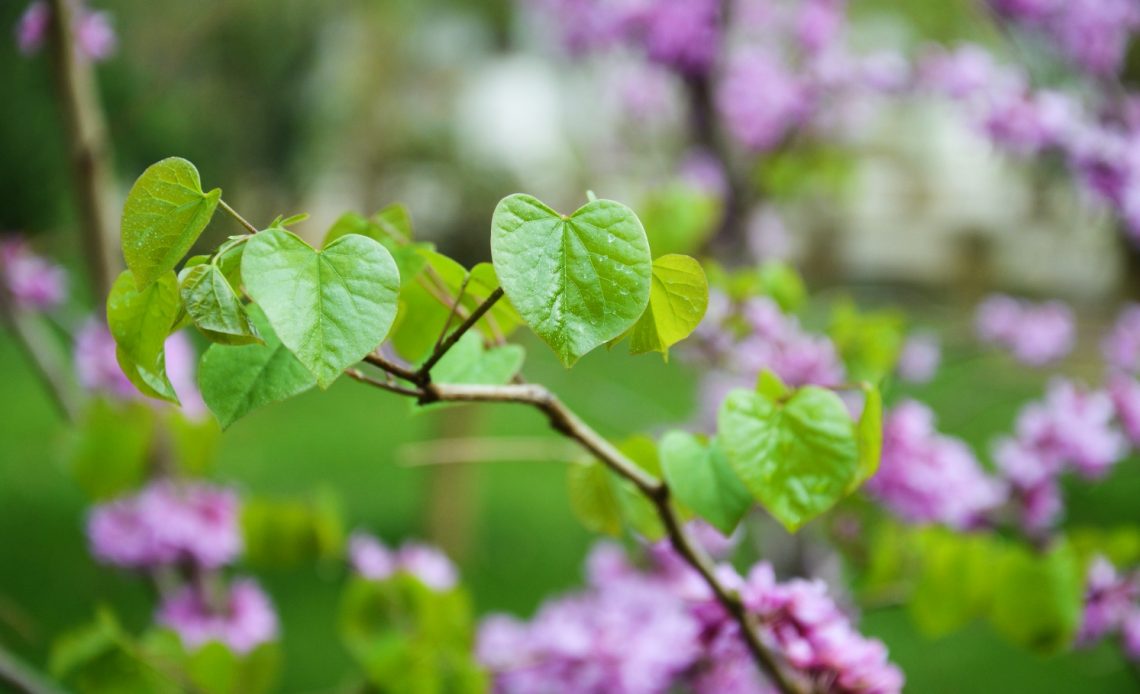

We’re here to help! Wild Yards is a completely free website that is 100% dedicated to helping you create a wildlife-friendly, sustainable yard. Read more
WildYards is reader-supported. When you buy a product through a link on our site, we may earn a comission. Every product is independently selected by our (obsessive) editors and our reviews are unbiased and objective. Read more about our mission or our privacy policy.
Plants with heart-shaped leaves add depth and texture to the landscape, encouraging onlookers to explore every inch of your flower beds.
These plants also make great gifts. If you have an important anniversary coming up, here are 8 beautiful plants that will help you send a clear message to your loved one.
Lilacs, philodendrons, elephant ears, cyclamens, and redbud trees produce gorgeous heart-shaped foliage that can dress up any landscape.
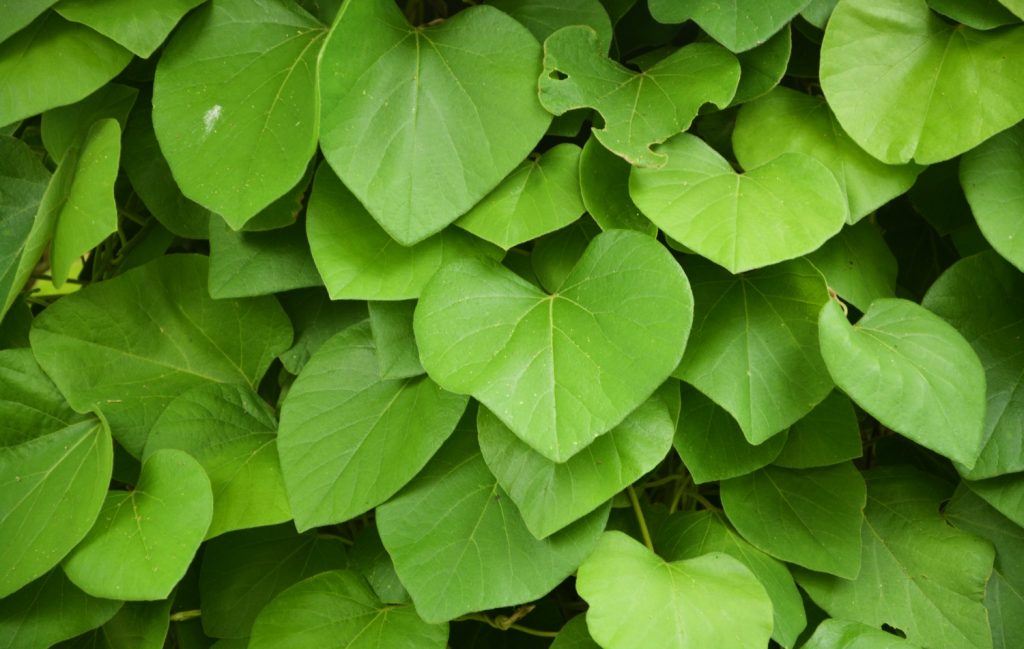
Redbud (Cercis canadensis)
After flowering in late winter to early spring, the redbud’s blooms are replaced with large, showy heart-shaped leaves that make this tree an instant showstopper.
The Eastern Redbud is a classic choice, popular with gardeners and wildlife. This tree features coppery brown to bright green leaves.
For a more exciting option, look for the ‘Hearts of Gold’ redbud, which produces brilliant golden-yellow foliage in spring. Or try the ‘Forest Pansy’ redbud, a cultivar with striking purple-red leaves.
| Hardiness zones | 4 through 9 |
| Maximum sizes | 10 to 30 feet tall by 20 to 35 feet wide; depending on the cultivar |
| Light requirements | Partial shade; more shade in warm climates, less in cool climates. |
| Soil type | Adaptable to a variety of well-draining soils, including loamy, sandy, and clay-rich. |
| Soil pH | Slightly acidic to neutral; 6.0 to 7.5 |
| Fertilizing needs | Use compost to fertilize to amend nutrient-poor soils. Has low nutrient needs. |
| Pruning requirements | Prune enough to shape the tree in late winter or early spring while the plant is still dormant. |
False Forget-Me-Not (Brunnera macrophylla)
This medium-sized perennial works well as a border for flower beds and walkways
It’s worth noting that false forget-me-nots are not drought-tolerant. Plants should be kept on a strict watering schedule to help them stay hydrated.
Deadheading can help the plants continue producing their pretty purple-blue flowers.
Dress up your backyard landscaping with ‘Jack Frost’, which produces silvery heart-shaped leaves with contrasting green veins. Or choose ‘Sea Heart’ instead for a pop of bright green color.
| Hardiness zones | 3 through 8 |
| Maximum sizes | 12 to 18 inches tall by 18 to 24 inches wide |
| Light requirements | Full to partial shade |
| Soil type | Well-draining loamy soil rich in decaying organic materials, like compost. |
| Soil pH | Slightly acidic to neutral; 6.0 to 7.0 |
| Fertilizing needs | Apply a general-purpose fertilizer in the spring. Has low nutrient needs. |
| Pruning requirements | Prune in spring after flowering. Trim away dead, misshapen growth. Remove no more than ⅓ of the plant. |
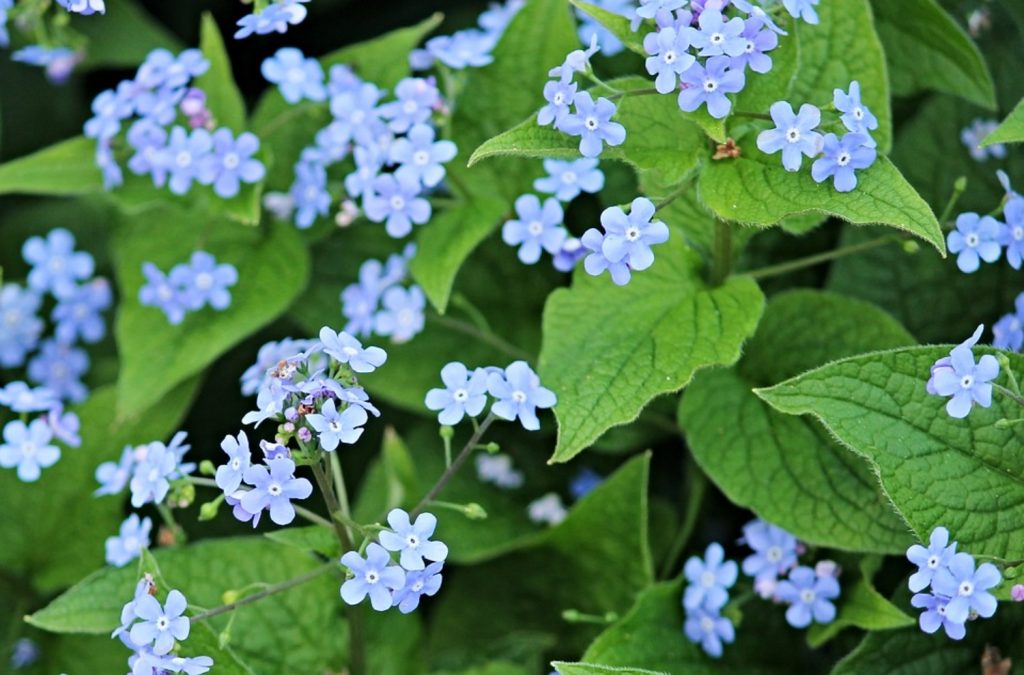
Philodendron (Philodendron bipinnatifidum)
Not all philodendrons produce big, beautiful heart-shaped leaves, but some varieties do. ‘Heart Leaf’ philodendron, in particular, produces uniformly heart-shaped foliage with a waxy matte finish.
‘Velvet Leaf’ and ‘Rojo Congo’ are two more varieties with the heart-shaped leaves you so desire — the former producing velvety leaves with a reddish bronze cast, and the latter erupting in bright red foliage.
Philodendrons are traditionally grown as indoor plants. Potted philodendrons should be repotted every few years, to prevent the plants from becoming rootbound.
| Hardiness zones | 9 through 11 |
| Maximum sizes | 6 inches to 10 feet tall by 3 feet to 10 feet wide; depending on the cultivar |
| Light requirements | Bright indirect sunlight |
| Soil type | Well-draining loamy soil rich in decaying organic materials. |
| Soil pH | Most cultivars prefer acidic soils between 5.5 to 6.5. Some cultivars can tolerate neutral to alkaline soils. |
| Fertilizing needs | Apply compost in the spring. Has low nutrient needs. |
| Pruning requirements | Prune in spring or summer when plants are actively growing. Trim away dead, misshapen growth. Remove no more than ⅓ of the plant. |
Lilac (Syringa vulgaris)
The lilac’s showy blossoms look as good as they smell, turning your garden into a pollinator’s paradise all spring long. But the plant’s heart-shaped leaves make this shrub a beautiful addition to your garden, even when it isn’t flowering.
Lilacs are relatively low-maintenance, which is why so many homeowners choose to include them in their foundation landscaping. That said, they do benefit from regular pruning. Trimming these plants back helps them produce bigger, more colorful flowers.
When freshly planted, lilacs rely on regular watering to get established. If lilacs don’t receive enough water, their leaves may curl.
‘Miss Kim’ is a cultivar that has seen a boom in popularity in recent years thanks to its compact size and shape. But ‘Sensation’ lilacs can grow up to 12 feet tall, creating a hedge of heart-shaped foliage, the perfect backdrop for the other plants in your landscaping.
| Hardiness zones | 2 through 9 |
| Maximum sizes | 8 to 15 feet tall by 6 to 12 feet wide |
| Light requirements | Full to partial sunlight |
| Soil type | Adaptable to a variety of soil types, including sandy, loamy, and clay-rich, as long as they are well-draining. |
| Soil pH | Slightly acidic to neutral; 6.5 to 7.5 |
| Fertilizing needs | Apply a balanced fertilizer like 10-10-10 in the spring. |
| Pruning requirements | Prune after flowering. Prune established lilacs by removing a third of the oldest woody growth down to ground level annually for 3 years to encourage a better shape. |
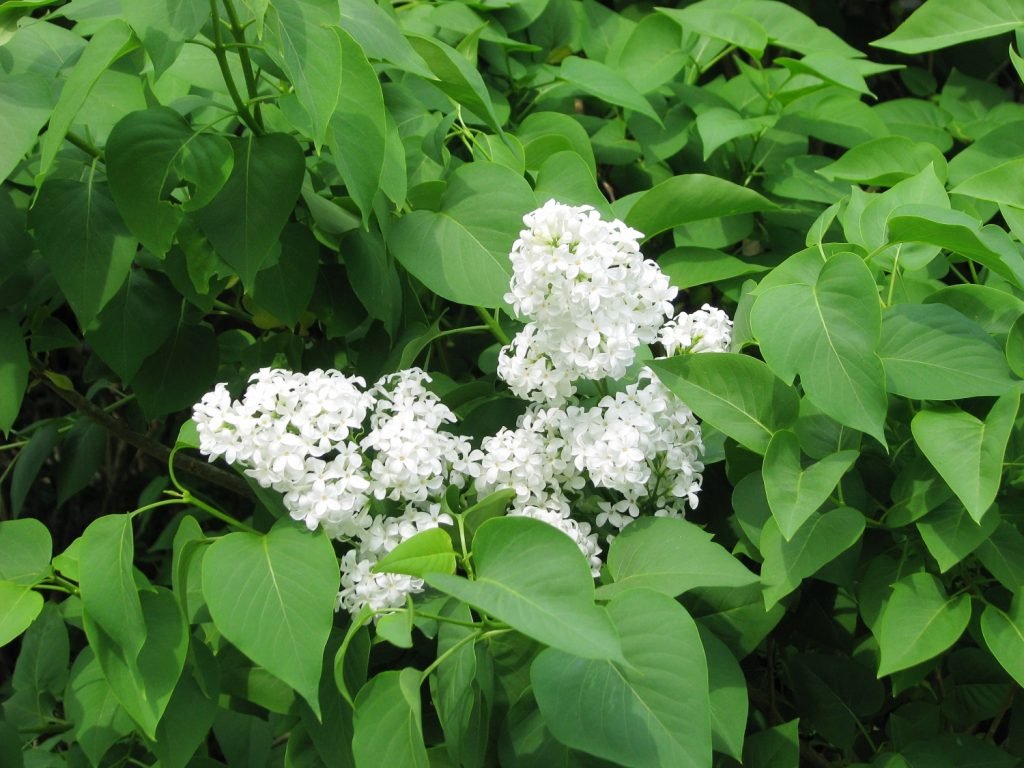
Elephant Ear (Colocasia esculenta)
Elephant ear is a subtropical plant that grows well in warm, moist climates. This plant is often paired with ferns and coleus.
The elephant ear plant produces large heart-shaped leaves. How big your elephant ear’s leaves will grow depends on their variety.
‘Fontane’s Elephant Ear’ produces small leaves that measure 6 to 8 inches long by 3 to 4 inches wide. But larger varieties, like ‘Giant Elephant Ear’, produce enormous leaves measuring up to 5 feet long by 4 feet wide.
| Hardiness zones | 8 through 11 |
| Maximum sizes | 2 to 15 feet tall by 1 to 10 feet wide |
| Light requirements | Full to partial shade |
| Soil type | Well-draining loamy soil rich in decaying organic materials, like manure. Soil should be kept moist. |
| Soil pH | Slightly acidic to neutral; 5.5 to 7.0 |
| Fertilizing needs | Apply a balanced fertilizer like 10-10-10 every 6 to 8 weeks throughout the growing season. |
| Pruning requirements | Remove dead or dying leaves as needed throughout the growing season. |
Cyclamen (Cyclamen periscum)
Cyclamen produces dainty green heart-shaped leaves, similar in color to English ivy. Cyclamen is a compact plant that can be grown as a border or ground cover.
In the late autumn and winter months, cyclamen blooms, producing tall pink, purple, and red flowers.
‘Rosalind’ and ‘Victoria’ are two popular varieties of cyclamen, with large green leaves and bright pink flowers.
| Hardiness zones | 5 through 9 |
| Maximum sizes | 4 to 24 inches tall by 8 to 12 inches wide |
| Light requirements | Bright indirect sunlight |
| Soil type | Damp but well-draining soils that are sandy to loamy. Does not grow well in clay-rich soils. |
| Soil pH | Acidic to neutral; 5.5 to 7.0 |
| Fertilizing needs | Apply 15-30-15 every 2 to 4 weeks during the active growth period. |
| Pruning requirements | Prune flowers down to the base of the plant after they’ve finished blooming. Remove dead and dying leaves as you see them. |
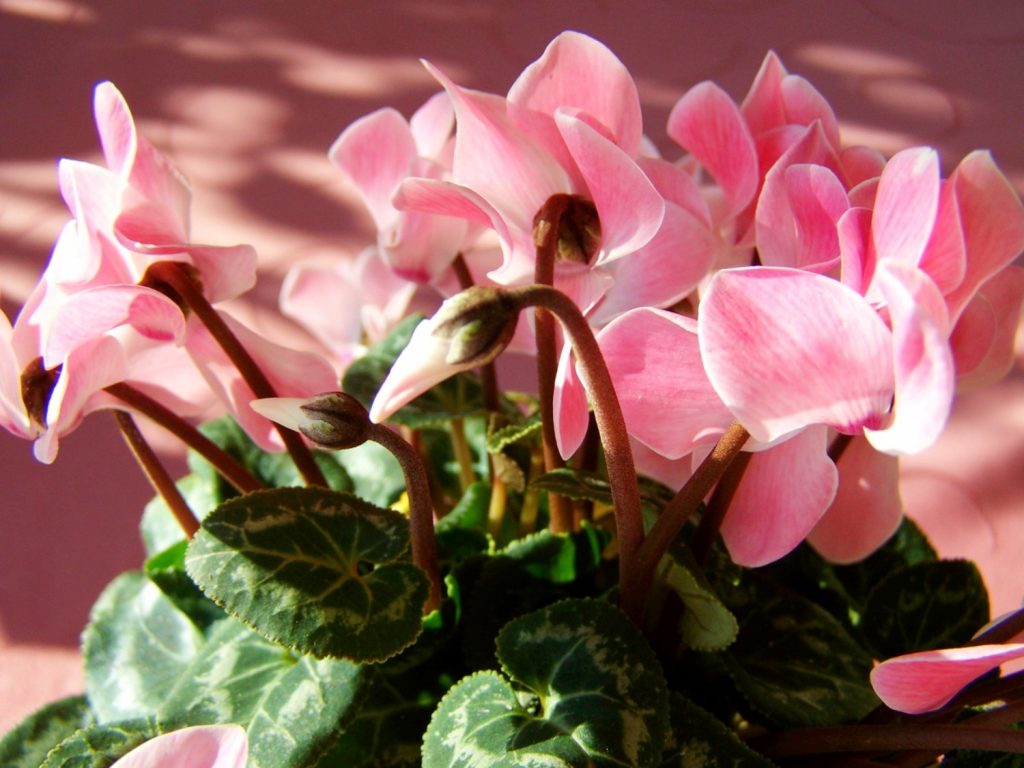
Morning Glory (Ipomoea purpurea)
Morning glory produces delicate heart-shaped leaves in shades of bright to medium green. This fast-growing climbing plant can be trained to grow along fences and up trellises. It can even be used as a ground cover.
Plants produce white, pink, purple, and blue trumpet-shaped flowers during the summer months, which open in the cool morning hours — hence the plant’s name.
Morning glories are easy to start from seeds and can self-seed easily. Plant a mixture of morning glory varieties, like ‘Heavenly Blue’ and ‘Scarlett O’Hara’, to add color to your landscaping, and attract your garden’s visitors to this plant’s lovely heart-shaped leaves.
| Hardiness zones | 2 through 11 |
| Maximum sizes | 6 to 19 feet tall by 3 to 6 feet wide. |
| Light requirements | Full to partial shade |
| Soil type | Well-draining sandy to loamy soil. Prefers soils that have been enriched with decaying organic materials. |
| Soil pH | Slightly acidic; 6.0 to 6.8 |
| Fertilizing needs | Does not need to be fertilized, but you can apply a balanced fertilizer, like 10-10-10 once a month during the growing season. |
| Pruning requirements | Remove damaged stems and dead flower heads as needed. |
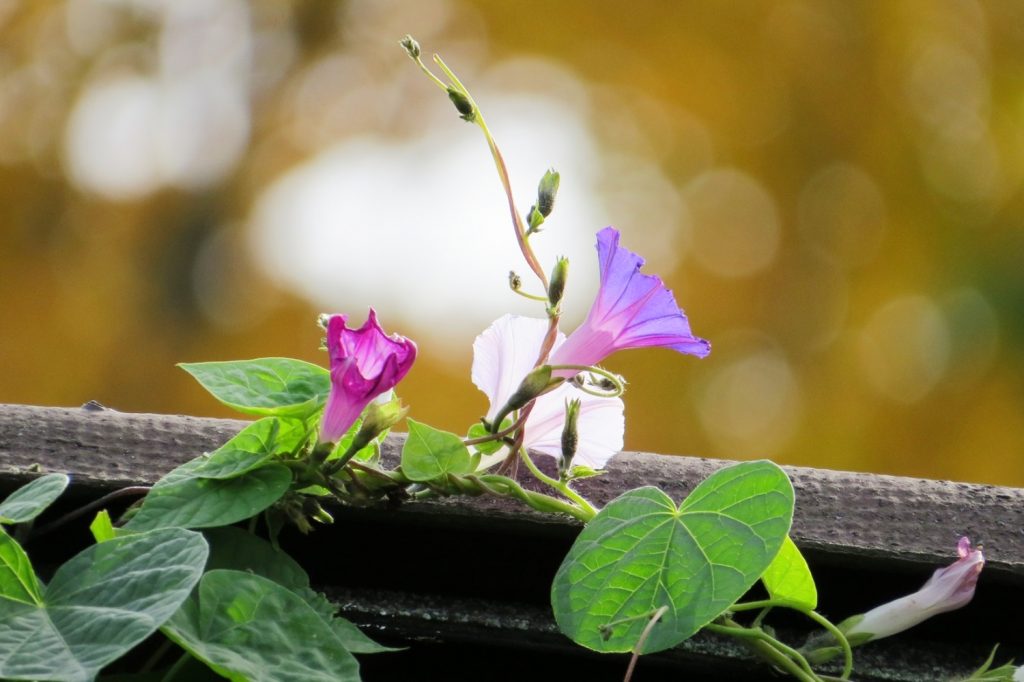
Flamingo Flower (Anthurium andraeanum)
The flamingo flower (also simply called anthurium) produces shiny heart-shaped leaves and long-lasting flowers in shades of red, pink, and white. The spathe, the flower’s large, singular “petal”, is actually a modified leaf.
‘White Heart’ anthurium produces classy white flowers accented with deep green heart-shaped leaves. But ‘Black Queen’ anthurium is an equally beautiful choice, featuring dark green foliage and blood-red flowers that, interestingly, resemble ripe jalapeno peppers in color and finish.
| Hardiness zones | 10 through 12 |
| Maximum sizes | 12 to 24 inches tall by 12 to 24 inches wide |
| Light requirements | Bright indirect light |
| Soil type | Well-draining loamy soil rich in decaying organic materials, like sphagnum moss. Does not grow well in heavy or compacted soils. |
| Soil pH | Acidic; 5.5 to 6.5 |
| Fertilizing needs | Apply a balanced fertilizer like 10-10-10 every 2 to 4 weeks during the growing season. |
| Pruning requirements | Remove dead foliage and flowers as needed. |
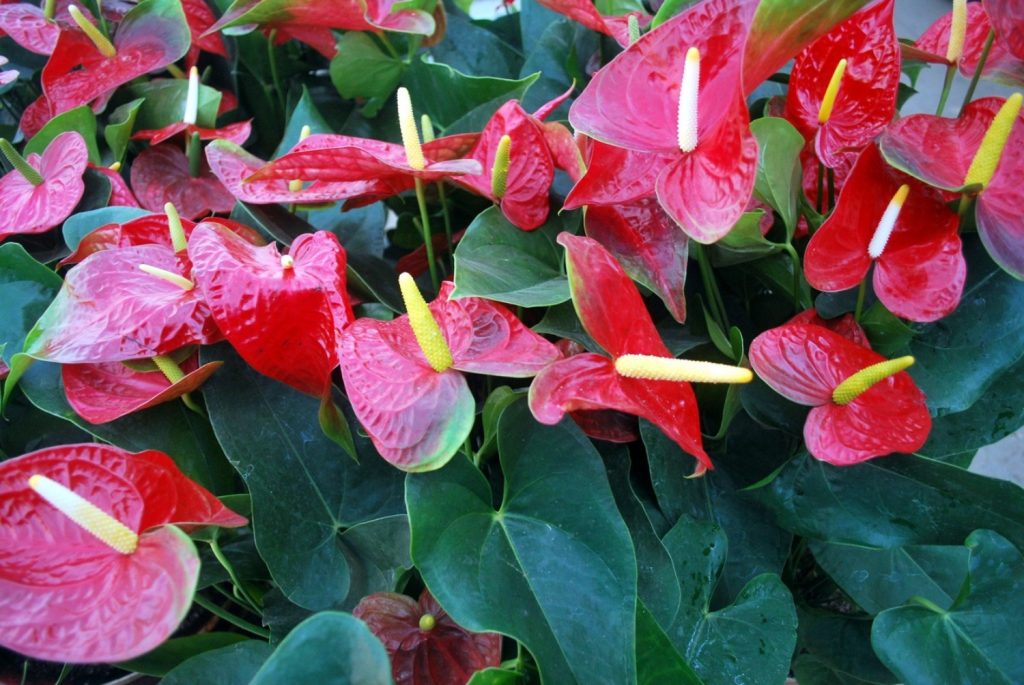
Choosing plants with heart-shaped leaves for your garden
When choosing plants for your garden, it’s always best to keep growing conditions in mind. Understanding how much sunlight and water your garden receives will help you make the best choice.
Understanding how much space you have to work with will help, too. Large plants, like elephant ears, would be a poor choice for an apartment balcony. So be realistic about how much room you have to offer.
Overall, growing plants with heart-shaped leaves is a great way to keep your garden visually pleasing all year long.
